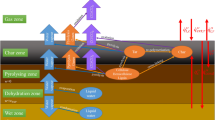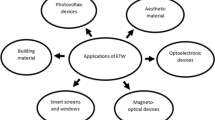Summary
Oven dry highly evacuated sticks of the sapwood of various hardwoods, 40 cm long by 1.0 to 1.2 cm in the radial and tangential directions, took up water to the extent of 44 to 82% of saturation by capillary flow in one minute. Heartwood sticks took up 15 to 38% of saturation in one minute. The initial rapid penetration was followed by a penetration in which the take up increase directly with the square root of elapsed time. In this range, the slope of toluene take up plots was about twice that of the water take up. This is close to the theoratical value on the basis of viscous flow control. The linear portion of the plots is followed by a curvilinear decrease in rate of take up to a final equilibrium value. Water take ups approached 100% of the theoretical values.
Times to 0.99 of theoretical filling with water varied from 9 minutes for tupelo gum sapwood to 14.6 to 17.3 days for white oak heartwood. Complete filling with toluene was never attained. Diffuse porous hardwoods filled to the extent of 93.5 to 96.5% of saturation. Ring porous oaks filled to the extent of 88 to 92%, the lower values being for heartwood. Edge coating of the sapwood of yellow poplar and yellow birch with epoxy glue reduced the rate of penetration only slightly. End coating reduced the rate to a higher degree. Moisture gradients in the fiber direction for tyloses-free hardwoods were negligible at various stages of penetration, indicating that filling of the vessels was practically instantaneous. White oak heartwood gave an initial longitudinal gradient followed by a negligible gradient, indicating that longitudinal penetration is primarily through the lumen of the fibers rather than continously through the vessels. Longitudinal penetration was calculated to be 31.5 times as deep as transverse penetration in 100 minutes and 33.3 times as deep in 25 minutes for white oak heartwood. The ratios are of the same order of magnitude as for Loblolly pine. In both cases the ratios are smaller than values calculated from the fiber dimensions alone as ray cell penetration and cross grain effects tend to lower the ratios.
Similar content being viewed by others
References
Christensen, G. N., Hergt, H. F. A. 1968. The apparent density of wood in non swelling liquids. Holzforschung 22 (6): 165.
Kellison, R. C., Zobel, B. J. 1971. Wood and fiber properties of five southern hardwood species, presented For. Prod. Res. Soc. meeting Pittsburg, Pa.
Kollmann, F. F. P., Côté, Jr. W. A. 1968. Principles of Wood Science and Technology Vol. I. Berlin-Heidelberg-New York: Springer-Verlag.
Panshin, A. J., de Zeeuw, C. 1964. Textbook of Wood Technology, Vol. I, 3rd Ed. New York: McGraw-Hill Book Co.
Siau, J. F. 1971. Flow in Wood. Syracuse, N. Y.: Syracuse Univ. Press.
Stamm, A. J. 1964. Wood and Cellulose Science. New York: Ronald Press Company.
Stamm, A. J. 1966. Maximum pore diameters for film materials. Forest Prod. J. 16 (12): 59–63.
Stamm, A. J. 1970. Maximum effective pit pore radii of the heartwood and sapwood of six softwoods as affected by drying and resoaking. Wood and Fiber 1: 263–269.
Stamm, A. J. 1970. Variations of the maximum tracheid and pit pore dimensions from pith to bark for ponderosa pine and redwood before and after drying determined by liquid displacement. Wood Sci. Technol. 4: 81–96.
Stamm, A. J. 1972. Maximum vessel diameters of hardwoods, Wood Sci. Technol. 6: 263–271.
Stamm, A. J., Clary, S. W., Elliott, W. J. 1968. Effective radii of the lumen and pit pores of softwoods. Wood Sci. 1: 93–101.
Wilfong, J. S. 1966. Specific gravity of wood substance. Forest Prod. J. 16 (1): 55.
Zobel, B. J. 1972. North Carolina State Cooperative Tree Improvement and Hardwood Research Program, 16th Annual Report, North Carolina State University.
Author information
Authors and Affiliations
Additional information
Paper No. 3947 of the Journal Series of North Carolina State University Agricultural Experiment Station, Raleigh, N. C.
Rights and permissions
About this article
Cite this article
Stamm, A.J. Penetration of hardwoods by liquids. Wood Science and Technology 7, 285–296 (1973). https://doi.org/10.1007/BF00351074
Received:
Issue Date:
DOI: https://doi.org/10.1007/BF00351074




